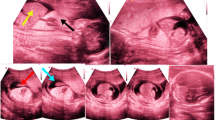Abstract
Fraser or Cryptophthalmos syndrome is a variable syndrome to the extent that cryptophthalmos might not be present in all cases. However, the main features are a “hidden eye”, other craniofacial abnormalities, renal abnormalities, syndactyly and abnormal genitalia. It may be classified as isolated cryptophthalmos or cryptophthalmos sequence and cryptophthalmos syndrome. The cryptophthalmos syndrome has an autosomal recessive mode of inheritance. Isolated cryptophthalmos has been reported as an autosomal dominant trait. Prenatal diagnosis is possible using ultrasonography and fetoscopy. We report three cases of cryptophthalmos. One with renal agenesis had cryptophthalmos syndrome and the other two had isolated cryptophthalmos or cryptophthalmos sequence.
Similar content being viewed by others
References
Gorlin RJ, Cohen MM, Levan LJ. Cryptophthalmos syndrome (Fraser syndrome). Syndromes of the Head and neck.Oxford Monographs on Medical Genetics. No. 19, 3rd edn., New York; Oxford University Press, 1990; 816–819.
Thomas IT, Frias JL, Felix V, Leon SD, Hernandez RA, Jones MC. Isolated and syndromic cryptophthalmos.Am J Med Genet (1986; 25: 85–98.
Gattuso J, Patton MA, Baraitser M. The clinical spectrum of the Fraser syndrome: report of three new cases and review.J Med Genet. 1987; 24 : 549–555.
Boyd PA, Keeling JW, Lindenbaum RH. Fraser syndrome (Cryptophthalmos-syndactyly syndrome): A review of eleven cases with postmortem finding.Am J Med Genet 1988; 31 : 159–168.
Sugar HS. The cryptophthalmos syndactyly syndrome.Am J Ophthalmol 1968; 66: 897–899.
Zehender W. Eine Missgeburt mit hautveberwachsenenn Augen oder kryptophthalmus.Klin Monatsbl Augenheilkd 1872; 10: 225–249.
Fraser GR. Our genetic load: A review of some aspects of genetical variation.Ann Hum Genet 1962; 25 : 387–415.
Kanhere S, Phadke V, Mathew A, Irani SF. Cryptophthalmos.Indian J Pediatr 1999; 66: 805–808.
Schauer GM, Dunn LK, Godmilow L, Eagle RC Jr., Knisely AS. Prenatal diagnosis of Fraser syndrome at 18.5 weeks gestation, with autopsy findings at 19 weeks.Am J Med Genet 1990; 37: 583–591.
Fryns JP, Van Schoubroeck D, Vandenberghe K, Nagels H, Klerckx P. Diagnostic echographic findings in Cryptophthalmos syndrome (Fraser syndrome).Prenatal Diagn 1997; 17: 582–586.
Bialer MG, Wilson WG. Syndromic Cryptophthalmos (letter).Am J Med Genet 1988; 30: 835–838.
Omori M, Chytel F. Mechanism of Vitamin A action.J Biol Chem 1982; 257 (23): 14370–14374.
Author information
Authors and Affiliations
Rights and permissions
About this article
Cite this article
Kabra, M., Gulati, S., Ghosh, M. et al. Fraser-Cryptophthalmos syndrome. Indian J Pediatr 67, 775–778 (2000). https://doi.org/10.1007/BF02723939
Issue Date:
DOI: https://doi.org/10.1007/BF02723939




